
The Majestic Milford Sound: New Zealand's Natural Wonder
Discover Milford Sound, New Zealand's stunning fjord, where towering peaks, cascading waterfalls, and lush rainforests create a breathtaking natural wonder.
Milford Sound, located in the southwest of New Zealand's South Island, is often regarded as one of the most beautiful places on Earth. Carved by glaciers during the ice ages, it boasts towering peaks, cascading waterfalls, and lush rainforests. The breathtaking fjord stretches for 15 kilometers inland from the Tasman Sea and is surrounded by steep cliffs, some of which rise over a thousand meters above the water. Visitors to Milford Sound can embark on a range of activities that allow them to fully immerse themselves in this stunning natural landscape. Boat cruises are a popular choice, offering a close-up view of the fjord's many waterfalls and wildlife, such as dolphins, seals, and penguins. For those seeking a more active experience, kayaking and diving are also available, providing a unique perspective of the underwater world and the towering cliffs above. The area is also renowned for its hiking trails, with the Milford Track being one of the most famous walks in the world. This four-day trek takes hikers through lush rainforests, past pristine lakes, and up to panoramic viewpoints where they can take in the full grandeur of Milford Sound. Regardless of how you choose to explore it, Milford Sound promises an unforgettable experience in one of the world's most awe-inspiring natural settings.
Local tips in Milford Sound
- Book your boat cruise in advance, especially during peak tourist season.
- Bring a waterproof jacket as the area receives a lot of rain.
- Consider staying overnight in nearby Te Anau for a more relaxed visit.
- Start the Milford Track early in the morning to avoid crowds.
- Keep an eye out for wildlife, such as dolphins and seals, especially during boat tours.
The Majestic Milford Sound: New Zealand's Natural Wonder
Milford Sound, located in the southwest of New Zealand's South Island, is often regarded as one of the most beautiful places on Earth. Carved by glaciers during the ice ages, it boasts towering peaks, cascading waterfalls, and lush rainforests. The breathtaking fjord stretches for 15 kilometers inland from the Tasman Sea and is surrounded by steep cliffs, some of which rise over a thousand meters above the water. Visitors to Milford Sound can embark on a range of activities that allow them to fully immerse themselves in this stunning natural landscape. Boat cruises are a popular choice, offering a close-up view of the fjord's many waterfalls and wildlife, such as dolphins, seals, and penguins. For those seeking a more active experience, kayaking and diving are also available, providing a unique perspective of the underwater world and the towering cliffs above. The area is also renowned for its hiking trails, with the Milford Track being one of the most famous walks in the world. This four-day trek takes hikers through lush rainforests, past pristine lakes, and up to panoramic viewpoints where they can take in the full grandeur of Milford Sound. Regardless of how you choose to explore it, Milford Sound promises an unforgettable experience in one of the world's most awe-inspiring natural settings.
When is the best time to go to Milford Sound?
Iconic landmarks you can’t miss
Milford Sound / Piopiotahi
Explore the breathtaking Milford Sound, a natural wonder in New Zealand's Fiordland National Park, with stunning cliffs, waterfalls, and rich wildlife.

RealNZ - Milford Sound Visitor Terminal
Explore the breathtaking beauty of Milford Sound with RealNZ Visitor Terminal, your gateway to unforgettable scenic cruises and natural wonders.

Southern Discoveries - Milford Sound Visitor Centre
Experience the breathtaking beauty of Milford Sound with guided tours, boat cruises, and kayaking adventures at Southern Discoveries Visitor Centre.

Mitre Peak Cruises
Experience the breathtaking beauty of Milford Sound with Mitre Peak Cruises, where stunning landscapes and serene waters await your exploration.

Cruise Milford
Discover the breathtaking beauty of Milford Sound through unforgettable boat tours with Cruise Milford, a premier tour operator in New Zealand's Fiordland.

The Chasm Viewing Bridge
Experience the breathtaking beauty of The Chasm Viewing Bridge in Fiordland National Park, where nature's power and artistry converge.

Milford Sound Lookout
Discover the breathtaking views of Milford Sound Lookout, a must-see destination in New Zealand's stunning Fiordland National Park.

Milford Sound Underwater Observatory - Southern Discoveries
Explore the underwater wonders of Milford Sound at the breathtaking Underwater Observatory, a unique experience in New Zealand's stunning fjord.
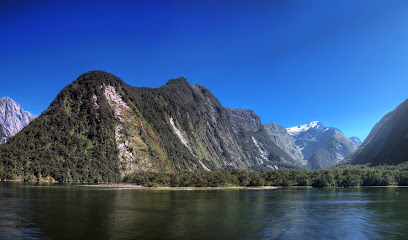
Bowen Falls
Experience the breathtaking beauty and serene atmosphere of Bowen Falls, a must-visit natural attraction in Fiordland National Park, New Zealand.

Milford Track Trailhead (Sandfly Point)
Explore the breathtaking Milford Track Trailhead at Sandfly Point, a gateway to Fiordland's stunning landscapes and iconic hiking experiences.

Fiordland Discovery
Experience the breathtaking beauty of Milford Sound with Fiordland Discovery, where adventure meets nature in New Zealand's stunning landscapes.

1855 lookout
Experience the breathtaking panoramas of Southland at 1855 Lookout, a must-see destination for all nature lovers and travelers exploring New Zealand.

Milford Sound Breakwater Walkway Lookout
Discover the unparalleled beauty of Milford Sound at the Breakwater Walkway Lookout, a must-visit destination for nature lovers and photographers alike.

Milford Sound Swing
Discover the thrill of the Milford Sound Swing, an iconic adventure amidst breathtaking natural beauty in New Zealand's stunning fjords.

Milford Sound Foreshore Walk
Explore the breathtaking Milford Sound Foreshore Walk, a serene hiking trail in Fiordland National Park, where stunning landscapes and wildlife await.

Unmissable attractions to see
Cruise Milford
Discover the stunning beauty of Milford Sound with Cruise Milford, an unforgettable boat tour in New Zealand's Fiordland National Park.

Lake Gunn Nature Walk
Experience the breathtaking beauty of Lake Gunn Nature Walk in Fiordland National Park, a serene hiking trail amidst lush forests and stunning landscapes.

Pop's View Lookout
Discover the stunning panoramic vistas of Pop's View Lookout in Southland, New Zealand, a must-visit for nature lovers and photographers alike.

Gertrude Valley Lookout
Experience the stunning beauty of Gertrude Valley Lookout in Fiordland National Park, a breathtaking vista point for nature lovers and adventurers.

Lake Marian Trail Carpark
Explore the stunning Hollyford River-Whakatipu Ka Tuka, a natural paradise in Southland, New Zealand, perfect for hiking and breathtaking views.
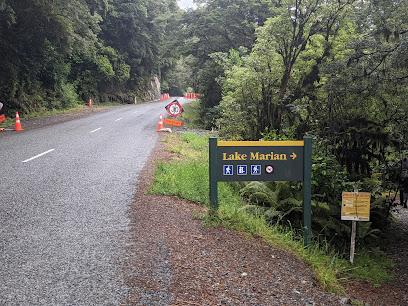
Gertrude Saddle
Experience the breathtaking beauty of Gertrude Saddle in Fiordland National Park, where adventure meets stunning natural landscapes.

Lake Gunn Viewpoint
Experience the breathtaking beauty of Lake Gunn Viewpoint in Fiordland National Park, a must-visit for nature lovers and photographers alike.

Seal Rock
Explore Seal Rock Wildlife Park, a haven for native wildlife in Southland, New Zealand, perfect for nature lovers and adventure seekers.

Giant Gate Falls
Experience the breathtaking beauty of Giant Gate Falls in New Zealand's Southland, a natural wonder perfect for nature lovers and adventure seekers.

Lake Marian
Explore the stunning alpine beauty of Lake Marian in Fiordland National Park, a serene escape into New Zealand's breathtaking landscapes.
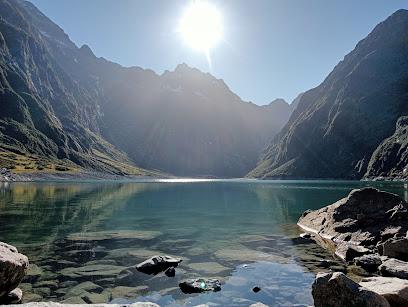
Lake Marian Track
Discover the enchanting Lake Marian Track in Fiordland National Park, a stunning hiking trail offering breathtaking alpine views and serene landscapes.

Mintaro Hut
Discover Mintaro Hut: a serene mountain retreat on the iconic Milford Track, surrounded by the stunning landscapes of Fiordland National Park.

Milford Sound Breakwater Walkway Lookout
Experience the unparalleled beauty of Milford Sound at the Breakwater Walkway Lookout, a stunning natural attraction in New Zealand's Southland region.
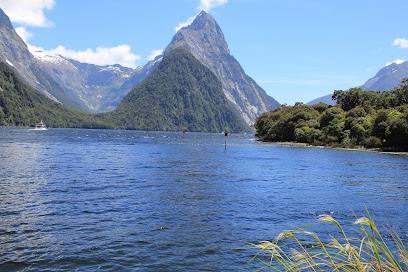
Dumpling Hut
Discover the flavors of Milford Sound at Dumpling Hut, where breathtaking views meet delectable dumplings in Fiordland's serene landscape.

Mackay Falls
Experience the breathtaking beauty of Mackay Falls in Fiordland, a serene destination perfect for nature lovers and outdoor enthusiasts.

Essential places to dine
Discover Milford Sound Cruises Information Centre & Café
Explore Milford Sound's natural beauty at Discover Milford Sound Cruises Information Centre & Café – your perfect stop for information and refreshments.

Pio Pio Restaurant
Discover authentic New Zealand cuisine amidst breathtaking landscapes at Pio Pio Restaurant in Fiordland National Park.

Markets, malls and hidden boutiques
Milford Sound / Piopiotahi
Experience the breathtaking beauty of Milford Sound / Piopiotahi, a stunning fjord in New Zealand's Southland, perfect for adventure and relaxation.

RealNZ - Milford Sound Visitor Terminal
Discover the breathtaking beauty of Milford Sound at the Visitor Terminal, your gateway to scenic fjord cruises and stunning natural landscapes.

Southern Discoveries - Milford Sound Visitor Centre
Discover the stunning beauty of Milford Sound at Southern Discoveries Visitor Centre – your gateway to unforgettable adventures in New Zealand's breathtaking fjord.

Milford Sound Lodge - Premium Chalets
Discover the unmatched beauty of Milford Sound at Milford Sound Lodge - Premium Chalets, where luxury meets nature in New Zealand's stunning landscapes.

Cruise Milford
Embark on a breathtaking journey through Milford Sound with Cruise Milford, exploring stunning landscapes and diverse wildlife in New Zealand's natural wonder.

The Chasm Viewing Bridge
Discover the mesmerizing beauty of The Chasm Viewing Bridge in Fiordland National Park, where nature's power and tranquility converge.

Discover Milford Sound Cruises Information Centre & Café
Discover Milford Sound’s beauty at the Information Centre & Café – your gateway to adventure in New Zealand’s stunning fjords.

Kiwi Country
Explore Kiwi Country in Te Anau for stylish men's and women's clothing that embodies New Zealand's unique culture and outdoor lifestyle.

Milford Sound
Experience the unparalleled beauty of Milford Sound, a stunning fjord in New Zealand's Fiordland National Park, where nature's wonders await.

Milford Sound Underwater Observatory - Southern Discoveries
Discover New Zealand's marine wonders at Milford Sound Underwater Observatory, where adventure meets education in a breathtaking setting.

Bowen Falls
Explore Bowen Falls, a stunning waterfall in Fiordland National Park, where nature's beauty and tranquility come together for an unforgettable experience.
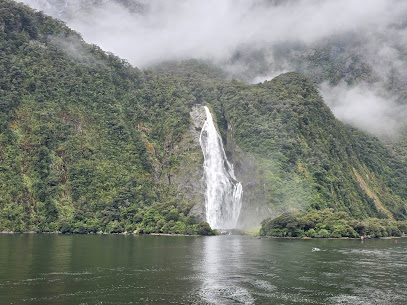
Descend Scuba Diving - Milford Sound
Explore the underwater wonders of Milford Sound with Descend Scuba Diving, where adventure meets breathtaking natural beauty.
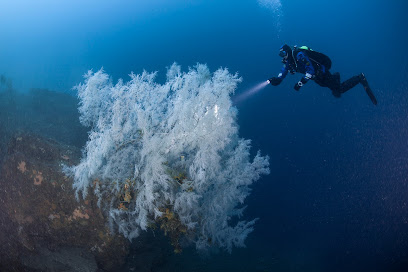
Recycle Boutique
Explore sustainable fashion at Recycle Boutique, Queenstown's premier destination for unique pre-loved clothing and eco-conscious shopping.

The Outpost Queenstown
Explore The Outpost Queenstown, your go-to gift shop for unique souvenirs and local treasures that embody the spirit of New Zealand.
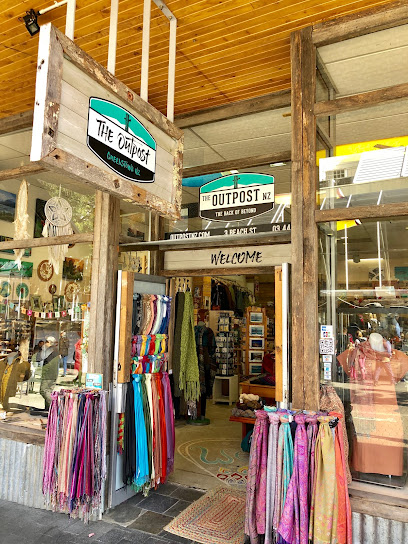
Luxmore Souvenirs 南方禮品中心
Discover authentic New Zealand gifts and souvenirs at Luxmore Souvenirs in Te Anau, a charming shop celebrating local culture and craftsmanship.
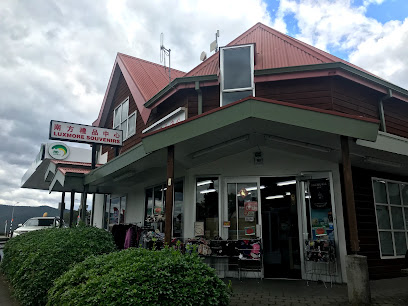
Essential bars & hidden hideouts
The Ranch Bar & Grill
Experience the charm of New Zealand cuisine at The Ranch Bar & Grill in Te Anau, perfect for families and food lovers alike.

Minus 5° ICE BAR
Discover a frosty wonderland at Minus 5° ICE BAR in Queenstown, where ice sculptures and chilled cocktails create an unforgettable experience.

The Fat Duck
Experience the flavors of Te Anau at The Fat Duck, a charming bar and restaurant with locally sourced dishes and a warm atmosphere.

Redcliff Restaurant and bar
Experience the flavors of Te Anau at Redcliff Restaurant and Bar, where local cuisine meets stunning landscapes and live music.

Milford Sound Lodge - Premium Chalets
Discover the enchanting Milford Sound Lodge, where premium chalets meet stunning natural beauty and exceptional New Zealand cuisine.

Alpine Centre Cafe & Bar
Experience the perfect blend of scenic views and culinary delights at the Alpine Centre Cafe & Bar in Southland, New Zealand.

Bailiez Cafe & Bar
Experience the flavors of Te Anau at Bailiez Cafe & Bar, where local ingredients meet international cuisine in a stunning setting.

Discover Milford Sound Cruises Information Centre & Café
Discover Milford Sound Cruises Information Centre & Café: Your gateway to breathtaking fjord adventures and delightful café experiences.

Eichardt's Bar
Discover Eichardt's Bar, where exquisite tapas and innovative cocktails meet stunning lakeside views in the heart of Queenstown.

Milford Sound
Explore Milford Sound: A stunning fjord in New Zealand's Fiordland, known for majestic cliffs, serene waters, and rich wildlife experiences.

Milford Sound Underwater Observatory - Southern Discoveries
Discover the enchanting underwater world at Milford Sound Underwater Observatory, where marine life thrives amidst stunning natural beauty.
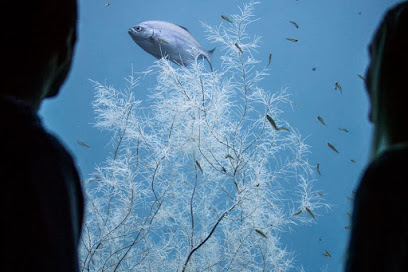
Milford Sound Lodge - Campervan Park
Discover the breathtaking beauty of Milford Sound at the Milford Sound Lodge - Campervan Park, the perfect spot for nature lovers and adventurers.

Black Dog Bar
Experience the best of Te Anau at Black Dog Bar, where delicious cocktails and a vibrant atmosphere await you.
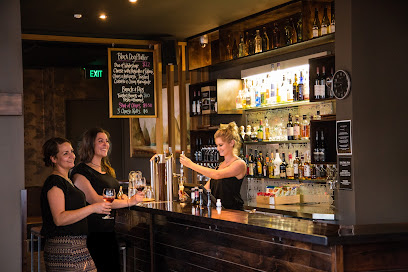
Pure Milford, Milford Sound
Experience the breathtaking beauty of Milford Sound with Pure Milford's guided tours through New Zealand's stunning natural wonder.

Milford Sound Marina
Experience the breathtaking beauty of Milford Sound Marina, your gateway to New Zealand's stunning fjords and wildlife.

Local Phrases about Milford Sound
-
- HelloKia ora
[key-ah or-ah] - GoodbyeHaere rā
[high-deh rah] - YesĀe
[eye] - NoKāo
[kah-oh] - Please/You're welcomeTēnā koe
[teh-nah koh-eh] - Thank youKia ora
[key-ah or-ah] - Excuse me/SorryWhakama
[fah-kah-mah] - How are you?Kei te pēhea koe?
[key teh pay-hah koh-eh] - Fine. And you?Kei te pai. Ā koe?
[key teh pie. eye koh-eh] - Do you speak English?Kōrerotia koe i te reo Pākehā?
[koh-reh-roh-tee-ah koh-eh ee teh reh-oh pah-keh-hah] - I don't understandKāore au e mōhio
[kah-oh-reh oh eh moh-hee-oh]
- HelloKia ora
-
- I'd like to see the menu, pleaseMe kite i te pānui kai, tēnā
[meh key-teh ee teh pah-new-ee kai, teh-nah] - I don't eat meatKāore au e kai mīti
[kah-oh-reh oh eh kai mee-tee] - Cheers!Kia ora!
[key-ah or-ah] - I would like to pay, pleaseMe utu, tēnā
[meh oo-too, teh-nah]
- I'd like to see the menu, pleaseMe kite i te pānui kai, tēnā
-
- Help!Āwhina!
[eye-fee-nah] - Go away!Haere atu!
[high-deh ah-too] - Call the Police!Whakapā atu ki te Pirihimana!
[fah-kah-pah ah-too kee teh pee-ree-hee-mah-nah] - Call a doctor!Whakapā atu ki te rongoā!
[fah-kah-pah ah-too kee teh rawn-goh-ah] - I'm lostI wareware au
[ee wah-reh-wah-reh oh] - I'm illE mate ana au
[eh mah-teh ah-nah oh]
- Help!Āwhina!
-
- I'd like to buy...Me hoko...
[meh hoh-koh] - I'm just lookingKei te titiro anō au
[key teh tee-tee-roh ah-noh oh] - How much is it?E hia te utu?
[eh hee-ah teh oo-too] - That's too expensiveHe roa rawa te utu
[heh roh-ah rah-wah teh oo-too] - Can you lower the price?Ka taea e koe te whakaiti i te utu?
[kah teh-ah eh koh-eh teh fah-kah-ee-tee ee teh oo-too]
- I'd like to buy...Me hoko...
-
- What time is it?He aha te wā?
[heh ah-hah teh wah] - It's one o'clockKotahi te wā
[koh-tah-hee teh wah] - Half past (10)Takiwa tekau
[tah-kee-wah teh-koh] - MorningAtapō
[ah-tah-poh] - AfternoonAhiahi
[ah-hee-ah-hee] - EveningPō
[poh] - YesterdayInāianei
[ee-nah-ee-ah-neh-ee] - TodayĀpōpō
[eye-poh-poh] - TomorrowĀpōpō
[eye-poh-poh] - 1Tahi
[tah-hee] - 2Rua
[roo-ah] - 3Toru
[toh-roo] - 4Whā
[fah] - 5Rima
[ree-mah] - 6Ono
[oh-noh] - 7Whitu
[fee-too] - 8Waru
[wah-roo] - 9Iwa
[ee-wah] - 10Tekau
[teh-koh]
- What time is it?He aha te wā?
-
- Where's a/the...?Kei hea te...?
[key heh-ah teh] - What's the address?He aha te wāhi?
[heh ah-hah teh wah-hee] - Can you show me (on the map)?Ka taea e koe te whakaatu i ahau (i runga i te mahere)?
[kah teh-ah eh koh-eh teh fah-kah-ah-too ee ah-how (ee roon-gah ee teh mah-heh-reh)] - When's the next (bus)?Āhea te mutunga o te (pahi)?
[eye-he-ah teh moo-too-nga oh teh pah-hee] - A ticket (to ....)He tiki (ki ...)
[heh tee-kee (kee)]
- Where's a/the...?Kei hea te...?
History of Milford Sound
-
Long before European settlers arrived, Milford Sound, known as Piopiotahi in Māori, was deeply woven into Māori legends. The legend speaks of the demigod Tū Te Rakiwhānoa, who carved the fiords with his adze to create a safe haven for his people. The area's waterfalls are said to be the tears of the grieving Tū, who mourned the loss of his beloved pet piopio, a thrush-like bird. The first Māori explorers navigated the challenging terrain of Fiordland, using the sound's abundant resources for sustenance and ceremonial purposes.
-
In 1773, during his second voyage, Captain James Cook anchored in what he mistakenly believed to be an inlet, naming it Milford Sound after Milford Haven in Wales. Although he never actually entered the sound, his mapping of the surrounding region was crucial for future explorers and settlers. Cook's expeditions marked the beginning of European interest in New Zealand's remote and rugged Fiordland.
-
The early 19th century saw a surge of European sealers and whalers arriving at Milford Sound. These maritime hunters were drawn by the rich marine life, particularly seals and whales, whose oils and pelts were highly valuable commodities. The sealing industry peaked in the early 1800s but led to the near-extinction of the local seal population, prompting a decline in the practice and a shift towards whaling, which persisted until the mid-19th century.
-
In 1888, the Scottish explorer Quintin McKinnon and his guide Ernest Mitchell made history by discovering the overland route to Milford Sound through what is now known as the Milford Track. This trail, which spans 53.5 kilometers, has since become one of the world's most famous hiking routes, celebrated for its breathtaking scenery and challenging terrain. McKinnon's exploration opened up the sound to greater tourism and accessibility.
-
In 1952, the New Zealand government officially established Fiordland National Park, encompassing Milford Sound and its surrounding areas. Spanning over 12,500 square kilometers, the park was created to preserve the unique biodiversity and stunning landscapes of the region. This designation has helped protect Milford Sound's pristine environment and has promoted sustainable tourism, allowing visitors to experience its natural beauty responsibly.
-
One of the most significant developments in making Milford Sound accessible was the completion of the Homer Tunnel in 1954. This 1.2-kilometer tunnel cuts through the Darran Mountain Range, providing a direct route to the sound. The Milford Road, which leads to the tunnel, is an engineering marvel in itself, offering travelers stunning vistas and making Milford Sound one of the most visited tourist destinations in New Zealand. The road and tunnel symbolize human ingenuity in overcoming the challenges posed by the region's rugged terrain.
Milford Sound Essentials
-
Milford Sound is located in Fiordland National Park on the southwestern coast of New Zealand's South Island. The nearest airport is Queenstown Airport, approximately 280 kilometers away. From Queenstown, you can drive to Milford Sound via State Highway 6 and State Highway 94, a journey that typically takes around 4 hours. Alternatively, you can take a bus or join a guided tour that includes transportation. Another option is to take a scenic flight from Queenstown or Te Anau, which offers aerial views of the stunning landscape.
-
Getting around Milford Sound is straightforward but limited due to its remote location. Most visitors explore the area on foot or by boat. Guided tours, including boat cruises and kayaking trips, are popular ways to experience the fiord. There are also scenic flights available for a bird's-eye view of the area. For those driving, parking is available near the Milford Sound Visitor Terminal, but it can fill up quickly during peak seasons.
-
The official currency in New Zealand is the New Zealand Dollar (NZD). Credit and debit cards are widely accepted in Milford Sound, including at the visitor terminal, cafes, and for tours. However, it is advisable to carry some cash, especially if you plan to visit more remote areas where card payment facilities may not be available. ATMs are available in Te Anau and Queenstown but not in Milford Sound itself.
-
Milford Sound is generally a very safe destination for tourists. There are no specific high-crime areas targeting tourists. However, it is always wise to take standard precautions such as keeping an eye on your belongings and avoiding isolated areas at night. Due to the remote location, weather conditions can change rapidly, so always check the weather forecast and be prepared for rain and cold temperatures.
-
In case of an emergency, dial 111 for immediate assistance. There is a small medical facility at the Milford Sound Lodge, but for serious medical issues, the nearest hospital is in Te Anau, approximately 120 kilometers away. It is highly recommended to have travel insurance that covers medical emergencies and evacuation. For minor health issues, be sure to carry a basic first-aid kit.
-
Fashion: Do wear comfortable and weather-appropriate clothing, including waterproof gear and sturdy shoes. Avoid wearing high heels or sandals as the terrain can be rugged. Religion: Respect local customs and traditions even though there are no specific religious practices in the area. Public Transport: Do be respectful and courteous on public buses or guided tours. Don’t be loud or disruptive. Greetings: A simple 'hello' or a nod is sufficient when greeting people. Eating & Drinking: Do try the local cuisine offered at the cafes. Don’t litter; always dispose of your trash properly to keep the environment pristine.
-
To experience Milford Sound like a local, consider visiting during the shoulder seasons (spring and autumn) when the area is less crowded but equally beautiful. Take a hike on one of the lesser-known trails like the Gertrude Saddle Track for stunning views without the crowds. Engage with local guides and staff, as they often have fascinating stories and insights about the area's history and ecology. If you have time, spend a night at Milford Sound Lodge to experience the tranquility of the fiord after the day-trippers have left.
Trending Landmarks in Milford Sound
-
Milford Sound / Piopiotahi
-
RealNZ - Milford Sound Visitor Terminal
-
Southern Discoveries - Milford Sound Visitor Centre
-
Mitre Peak Cruises
-
Cruise Milford
-
The Chasm Viewing Bridge
-
Milford Sound Lookout
-
Milford Sound Underwater Observatory - Southern Discoveries
-
Bowen Falls
-
Milford Track Trailhead (Sandfly Point)
-
Fiordland Discovery
-
1855 lookout
-
Milford Sound Breakwater Walkway Lookout
-
Milford Sound Swing
-
Milford Sound Foreshore Walk
Nearby Cities to Milford Sound
-
Things To Do in Wanaka
-
Things To Do in Invercargill
-
Things To Do in Dunedin
-
Things To Do in Timaru
-
Things To Do in Greymouth
-
Things To Do in Christchurch
-
Things To Do in Kaikoura
-
Things To Do in Nelson
-
Things To Do in Blenheim
-
Things To Do in Wellington
-
Things To Do in Masterton
-
Things To Do in Whanganui
-
Things To Do in Palmerston North
-
Things To Do in New Plymouth
-
Things To Do in Napier











